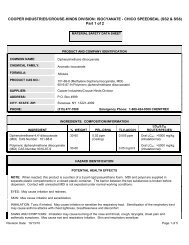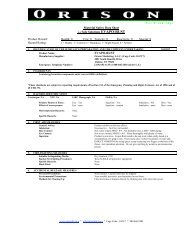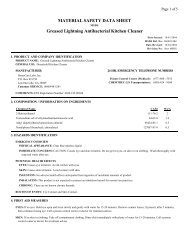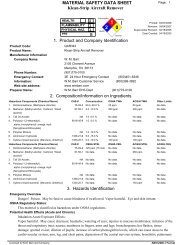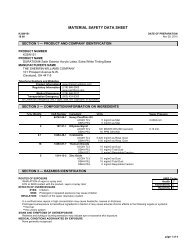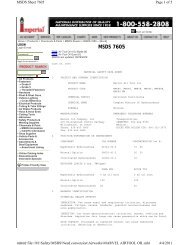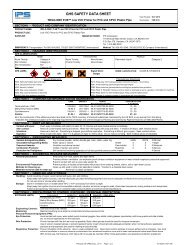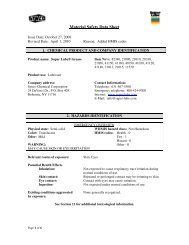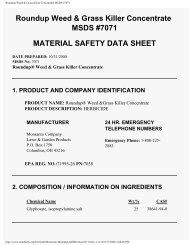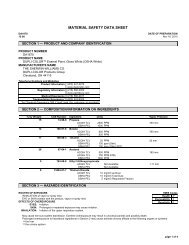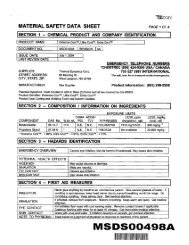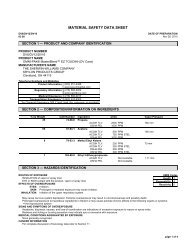MATERIAL SAFETY DATA SHEET - Multi-Craft Contractors, Inc.
MATERIAL SAFETY DATA SHEET - Multi-Craft Contractors, Inc.
MATERIAL SAFETY DATA SHEET - Multi-Craft Contractors, Inc.
Create successful ePaper yourself
Turn your PDF publications into a flip-book with our unique Google optimized e-Paper software.
PART I<br />
<strong>MATERIAL</strong> <strong>SAFETY</strong> <strong>DATA</strong><br />
<strong>SHEET</strong><br />
Prepared to U.S. OSHA, CMA, ANSI and Canadian WHMIS, And European Community Standards<br />
What is the material and what do I need to know in an emergency<br />
1. PRODUCT IDENTIFICATION<br />
TRADE NAME (AS LABELED):<br />
LOW VOC PVC SOLVENT CEMENTS:<br />
902 EZ-1 903 POOL PRO 920 TRANSITION 905 PVC CLEAR<br />
904 HD Clear 906 HD GRAY 922 WET WELD<br />
CHEMICAL NAME/CLASS:<br />
Polyvinyl Chloride / Solvent Mixture<br />
PRODUCT USE:<br />
Solvent Cement for PVC-Based Material<br />
SUPPLIER/MANUFACTURER'S NAME:<br />
E-Z Weld, <strong>Inc</strong><br />
U.S. BUSINESS PHONE: 1-800-327-8460; 1-561-844-0241<br />
U.S. ADDRESS:<br />
1661 Old Dixie Highway<br />
Riviera Beach, FL 33404<br />
U.S. EMERGENCY PHONE:<br />
CHEMTREC:<br />
1-800-424-9300 (U.S. and Canada)<br />
1-703-527-3887 (International)<br />
DATE OF PREPARATION: November 12 2008<br />
2. COMPOSITION and INFORMATION ON INGREDIENTS<br />
CHEMICAL<br />
NAME<br />
CAS # EINECS # % w/w EXPOSURE LIMITS IN AIR<br />
Tetrahydrofuran 109-99-9 203-726-8 40-60 50<br />
A3 (confirmed<br />
Animal Carcinogen<br />
with Unknown<br />
Relevance to<br />
Humans)<br />
Methyl Ethyl<br />
Ketone<br />
Polyvinyl<br />
Chloride Resin<br />
ACGIH<br />
OSHA<br />
TLV STEL PEL STEL IDLH OTHER<br />
ppm ppm ppm ppm ppm<br />
100 200 250<br />
(vacated<br />
1989 PEL)<br />
78-93-3 201-159-0 1-12 200 300 200 300<br />
(vacated<br />
1989 PEL)<br />
2000<br />
(based<br />
on LEL)<br />
3000<br />
NIOSH REL:<br />
TWA = 200<br />
STEL = 250<br />
DFG MAK: 50<br />
NIOSH REL:<br />
TWA = 200<br />
STEL = 300<br />
DFG MAK: 200<br />
Carcinogen: EPA-<br />
D<br />
9002-86-2 206-625-7 < 25 NE NE NE NE NE Carcinogen:<br />
IARC-3;<br />
Cyclohexanone 108-94-1 203-631-1 8-18 25, skin,<br />
A3 (confirmed<br />
Animal Carcinogen<br />
with Unknown<br />
Relevance to<br />
Humans)<br />
NE = Not Established. C = Ceiling Limit. See Section 16 for Definitions of Terms Used.<br />
NE 50<br />
25<br />
(vacat<br />
ed<br />
1989<br />
PEL)<br />
NE 700<br />
NIOSH REL:<br />
TWA = 25, Skin<br />
DFG MAK:<br />
Danger of<br />
Cutaneous<br />
Absorption<br />
Carcinogen:<br />
IARC-3; MAK-B<br />
LVOC PVC CEMENT PRODUCTS<br />
PAGE 1 OF 11
2. COMPOSITION and INFORMATION ON INGREDIENTS (Continued)<br />
CHEMICAL<br />
NAME<br />
CAS # EINECS # % w/w EXPOSURE LIMITS IN AIR<br />
ACGIH<br />
TLV<br />
ppm<br />
Acetone 67-64-1 200-662-2 5-20 500 A4 (Not<br />
Classifiable as a<br />
Human Carcinogen)<br />
Silicon Dioxide<br />
(exposure limits<br />
are for silicaamorphous<br />
diatomaceous<br />
earth)<br />
112945-52-5 Unlisted Balance For CAS # 61790-<br />
53-2 (uncalcined)<br />
10 mg/m 3 (Inhalable<br />
particulate)<br />
3 mg/m 3 (Respirable<br />
particulate)<br />
ST<br />
EL<br />
pp<br />
m<br />
750 1000<br />
NE<br />
OSHA<br />
PEL STEL IDLH OTHER<br />
ppm ppm ppm<br />
750<br />
20 mppcf or<br />
80 mg/m 3<br />
% SiO 2<br />
NE<br />
1000<br />
6 mg/m 3 (vacated<br />
1989 PEL)<br />
2500<br />
NIOSH REL:<br />
TWA = 250DFG MAK:<br />
500<br />
Carcinogen: EPA-D<br />
3000 NIOSH REL: 6 mg/m 3<br />
mg/<br />
m 3 DFG MAK: 4 mg/m 3<br />
(CAS # 61790-53-2)<br />
Carcinogen:<br />
IARC-3<br />
(CAS # 61790-53-2)<br />
NE = Not Established. C = Ceiling Limit. See Section 16 for Definitions of Terms Used.<br />
3. HAZARD IDENTIFICATION<br />
EMERGENCY OVERVIEW: This is an extremely flammable liquid with an ether-like odor. This product comes in a variety<br />
of colors. Inhalation overexposures to the vapors of this product can cause central-nervous system effects (e.g.,<br />
dizziness, drowsiness, nausea, and headaches). This product can be mildly to severely irritating to the eyes, skin, and<br />
other contaminated tissue. Vapors of this product are heavier than air and may travel to a source of ignition and<br />
flashback to a leak or open container. Tetrahydrofuran, a component of this product, is known to form explosive peroxides<br />
under certain circumstances. Emergency responders must wear the proper personal protective equipment (and have<br />
appropriate fire protection) suitable for the situation to which they are responding.<br />
SYMPTOMS OF OVEREXPOSURE BY ROUTE OF EXPOSURE: The<br />
most significant routes of occupational overexposure are inhalation and HAZARDOUS <strong>MATERIAL</strong> INFORMATION SYSTEM<br />
contact with skin and eyes. The symptoms of overexposure to this product,<br />
via route of exposure, are as follows:<br />
INHALATION: Inhalation of vapors, mists, or sprays of this product can be<br />
HEALTH<br />
(BLUE) 2<br />
irritating to the nose, throat, mucous membranes, and other tissues of the<br />
respiratory system. Symptoms of overexposure can include coughing,<br />
sneezing, and shortness of breath. Additionally, the components of this<br />
product are central nervous system depressants. Symptoms of overexposure<br />
FLAMMABILITY (RED) 3<br />
can include drowsiness, dizziness, fatigue, headache, nausea,<br />
and general anesthetic effects. Inhalation of high concentrations of this<br />
product (as may occur in a poorly-ventilated area) may be fatal. Based on<br />
clinical studies involving test animals, Cyclohexanone and Tetrahydrofuran, REACTIVITY (YELLOW) 1<br />
components of this product, may cause liver and kidney damage after longterm<br />
inhalation overexposures.<br />
This product must be used with adequate ventilation. Mechanical PROTECTIVE EQUIPMENT<br />
C/D<br />
exhaust may be needed. Ensure exposure to vapors is minimized by use of<br />
appropriate engineering controls, work practices, and personal protective<br />
equipment, as described in the remainder of this document.<br />
CONTACT WITH SKIN or EYES: Contact with this product can be irritating<br />
EYES RESPIRATORY HANDS BODY<br />
SEE SECTION 8<br />
to contaminated skin and eyes. Vapors of this product can redden and<br />
irritate the eyes. If the eyes are contaminated with splashes, sprays or<br />
mists of this product, reddening, tearing, and corneal opacity can occur.<br />
For routine applications.<br />
The liquid can be mildly to severely irritating to contaminated skin<br />
(depending on duration of exposure). Prolonged or repeated skin over-exposures can lead to dermatitis.<br />
SKIN ABSORPTION: Skin absorption is a potential route of overexposure<br />
for Cyclohexanone (a component of this product). Symptoms of such See Section 16 for Definition of Ratings<br />
exposure can include those described under “Inhalation” and “Contact With Skin and Eyes”.<br />
LVOC PVC CEMENT PRODUCTS<br />
PAGE 2 OF 11
3. HAZARD IDENTIFICATION (Continued)<br />
INGESTION: Ingestion is not anticipated to be a significant route of occupational overexposure for this product. If ingestion<br />
occurs, refer to Section 4 (First-Aid Measures) and get medical help immediately. If ingestion of this product does occur,<br />
symptoms of such over-exposure can include nausea, vomiting, and other symptoms described for “Inhalation”. Ingestion<br />
can also lead to liver and kidney damage. Ingestion of this product may be fatal.<br />
INJECTION: Injection is not anticipated to be a significant route of over-exposure for this product. If injection does occur (i.e.<br />
through a puncture by an object contaminated with the product), local irritation and swelling can occur. Additional symptoms<br />
may include those described for “Inhalation”.<br />
HEALTH EFFECTS OR RISKS FROM EXPOSURE: An Explanation in Lay Terms.<br />
ACUTE: Over-exposures to this product can be irritating to the eyes, skin, and mucous membranes, and can also cause<br />
central-nervous system effects (dizziness, drowsiness, nausea and headaches). Ingestion of this product, or inhalation of<br />
high concentrations of this product’s vapors, may be fatal.<br />
CHRONIC: Prolonged or repeated skin exposures can lead to dermatitis (dryness, reddening and irritation of the skin).<br />
Tetrahydrofuran, a component of this product, may cause liver and kidney damage after long-term inhalation overexposures.<br />
There is limited evidence from animal studies that Methyl Ethyl Ketone, a component of this product, is a reproductive toxin.<br />
Refer to Section 11 (Toxicological Information) for additional information. A report from the National Toxicology Program<br />
(NTP) has suggested that exposure of mice and rats to Tetrahydrofuran (THF) vapor levels up to 1800 ppm 6 hr/day, 5<br />
days/week for their lifetimes caused an increased incidence of kidney tumors in male rats and liver tumors in female mice. No<br />
evidence of tumors was seen in female rats or male mice. The significance of these findings for human health is unclear at<br />
this time, and may be related to "species specific" effects. Elevated incidences of tumors in humans have not been reported<br />
for THF. The NTP, IARC, or OSHA does not list THF as a carcinogen. One THF vendor (DuPont) has recommended a<br />
reduction in the "acceptable exposure limit" from 200 ppm to 25 ppm, 8 and 12 hour time weighted average and a STEL of<br />
75 ppm.<br />
TARGET ORGANS: Acute: Skin, eyes, respiratory system, central nervous system. Chronic: Liver, kidneys.<br />
PART II What should I do if a hazardous situation occurs<br />
4. FIRST-AID MEASURES<br />
SKIN EXPOSURE: If this product contaminates the skin, immediately begin decontamination with running water. Minimum<br />
flushing is for 15 minutes. Remove exposed or contaminated clothing, taking care not to contaminate eyes. The<br />
contaminated individual must seek medical attention if any adverse effect occurs.<br />
EYE EXPOSURE: If this product's liquid or vapors enter the eyes, open victim's eyes while under gently running water. Use<br />
sufficient force to open eyelids. Have victim "roll" eyes. Minimum flushing is for 15 minutes. The contaminated individual<br />
must seek immediate medical attention.<br />
INHALATION: If vapors, mists, or sprays of this product are inhaled, remove victim to fresh air. If necessary, use artificial<br />
respiration to support vital functions. Remove or cover gross contamination to avoid exposure to rescuers.<br />
INGESTION: If this product is swallowed, CALL PHYSICIAN OR POISON CONTROL CENTER FOR MOST CURRENT<br />
INFORMATION. If professional advice is not available, do not induce vomiting. The contaminated individual should drink<br />
milk, egg whites, or large quantities of water. Never induce vomiting or give diluents (milk or water) to someone who is<br />
unconscious, having convulsions, or unable to swallow.<br />
The contaminated individual must be taken for medical attention, especially if any adverse effect occurs. Rescuers should be<br />
taken for medical attention, if necessary. Take a copy of label and MSDS to health professional with victim.<br />
5. FIRE-FIGHTING MEASURES<br />
The following information is variable, depending on the blend. The following<br />
information is for Tetrahydrofuran, the main solvent component of this product.<br />
NFPA RATING<br />
FLAMMABILITY<br />
FLASH POINT: -17°C (4.1°F)<br />
AUTOIGNITION TEMPERATURE: 321°C (610°F)<br />
FLAMMABLE LIMITS (in air by volume): Lower (LEL): 1.8%<br />
3<br />
Upper (UEL): 11.8%<br />
The following information is for the product.<br />
HEALTH<br />
2 1<br />
REACTIVITY<br />
FIRE EXTINGUISHING <strong>MATERIAL</strong>S:<br />
Water Spray: YES (for cooling only)<br />
Carbon Dioxide: YES<br />
Foam: YES<br />
Dry Chemical: YES<br />
OTHER<br />
Halon: YES Other: Any "B" See Section 16 for Definition of Ratings<br />
LVOC PVC CEMENT PRODUCTS<br />
PAGE 3 OF 11
Class.<br />
5. FIRE-FIGHTING MEASURES (Continued)<br />
UNUSUAL FIRE AND EXPLOSION HAZARDS: This is a Class I-B Flammable Liquid. When involved in a fire, this material<br />
may ignite and produce irritating vapors and toxic gases (e.g., carbon monoxide, carbon dioxide). This material<br />
will readily ignite at room temperature. The vapors are heavier than air and may travel to a source of ignition, and flash back<br />
to a leak or open container. Tetrahydrofuran can form potentially explosive peroxides; closed containers contaminated with<br />
peroxides can rupture violently in the heat of a fire.<br />
Explosion Sensitivity to Mechanical Impact: Not sensitive.<br />
Explosion Sensitivity to Static Discharge: The vapors of this product can be ignited by static electrical energy.<br />
SPECIAL FIRE-FIGHTING PROCEDURES: <strong>Inc</strong>ipient fire responders should wear eye protection. Structural firefighters<br />
must wear Self-Contained Breathing Apparatus and full protective equipment. If it is safe to do so, allow small fires involving<br />
this product to burn-out, while protecting exposures. If possible, prevent runoff water from entering storm drains, bodies of<br />
water, or other environmentally sensitive areas. If necessary, rinse contaminated equipment thoroughly before returning such<br />
equipment to service.<br />
6. ACCIDENTAL RELEASE MEASURES<br />
RELEASE RESPONSE: In case of a spill, clear the affected area and protect people. Uncontrolled releases should be<br />
responded to by trained personnel using pre-planned procedures. Proper protective equipment should be used.<br />
Small releases (e.g., 1-pint) must be cleaned-up by personnel wearing gloves, goggles, and appropriate eye protection.<br />
Face shields must be worn if splashes or sprays of this product may be generated. In the event of a non-incidental release<br />
(e.g., five, 1-gallon containers leaking simultaneously in a poorly-ventilated area), the minimum Personal Protective<br />
Equipment should be Level B: triple-gloves (rubber gloves and nitrile gloves, over latex gloves), chemically resistant<br />
suit and boots, hard-hat, and Self-Contained Breathing Apparatus. Level B should always be used during responses in<br />
which the oxygen level is below 19.5% or unknown.<br />
Eliminate all sources of ignition before spill clean-up begins. Use non-sparking tools. Absorb spilled liquid with activated<br />
carbon, polypads or other suitable absorbent materials. Monitor the area for combustible vapors and the level of oxygen.<br />
Monitoring must indicate less than 10 % of the LEL (see Section 5, Fire-Fighting Measures) and greater than 19.5% Oxygen<br />
is in the atmosphere before personnel are permitted in the area without Level B Protection. Place all spill residue in an<br />
appropriate container and seal. Dispose of in accordance with U.S. Federal, State, or local procedures, the applicable<br />
standards of Canada and its Provinces, or the appropriate requirements of European Community member States (see<br />
Section 13, Disposal Considerations).<br />
PART III How can I prevent hazardous situations from occurring<br />
7. HANDLING and STORAGE<br />
WORK PRACTICES AND HYGIENE PRACTICES: As with all chemicals, avoid getting this product ON YOU or IN YOU.<br />
Wash thoroughly after handling this product. Do not eat, drink, smoke, or apply cosmetics while handling this product. Avoid<br />
breathing vapors or mists generated by this product. Remove contaminated clothing immediately.<br />
STORAGE AND HANDLING PRACTICES: All employees who handle this material should be trained to handle it safely.<br />
Containers of this product must be properly labeled. If this mixture is used in other types of containers, only use portable<br />
containers approved for flammable liquids. Post “NO SMOKING” signs, where appropriate in storage and use areas. Use<br />
non-sparking tools. Bond and ground during transfer of material. Store containers of the product in a cool, dry location, away<br />
from direct sunlight, sources of intense heat, or where freezing is possible. Material should be stored in secondary<br />
containers, or in a diked area, as appropriate. Store containers away from incompatible chemicals. Keep container tightly<br />
closed when not in use. Storage areas should be made of fire-resistant materials. Inspect all incoming containers before<br />
storage, to ensure containers are properly labeled and not damaged. Refer to NFPA 30, Flammable and Combustible<br />
Liquids Code for additional information on storage. Empty containers may contain residual flammable liquid or vapors.<br />
Therefore, empty containers should be handled with care. Do not expose ”empty” containers to welding touches, or any<br />
other source of ignition.<br />
8. EXPOSURE CONTROLS - PERSONAL PROTECTION<br />
VENTILATION AND ENGINEERING CONTROLS: Use with adequate ventilation. Mechanical exhaust may be needed.<br />
Emergency eye-wash/safety showers: where there is any possibility that an employee's eyes may be exposed to this<br />
substance, the employer should provide an eye-wash fountain/safety shower within the work area for emergency use.<br />
LVOC PVC CEMENT PRODUCTS<br />
PAGE 4 OF 11
RESPIRATORY PROTECTION: Respiratory protection is not generally needed when using this product. Maintain airborne<br />
contaminant concentrations below guidelines listed in Section 2 (Composition, Information on Ingredients). If respiratory<br />
protection is needed, use only protection authorized in 29 CFR 1910.134 or applicable State regulations. Use<br />
8. EXPOSURE CONTROLS - PERSONAL PROTECTION (Continued)<br />
supplied air respiration protection if oxygen levels are below 19.5% or are unknown. Respiratory protection guidelines for<br />
Tetrahydrofuran (a component of this product) are provided on the following page.<br />
NIOSH/OSHA RECOMMENDATIONS FOR TETRAHYDROFURAN CONCENTRATIONS IN AIR:<br />
UP TO 2000 ppm: Supplied Air Respirator (SAR) operated in a continuous-flow mode, full-facepiece chemical<br />
cartridge respirator with organic vapor cartridge(s), gas mask with organic vapor canister, powered<br />
air-purifying respirator with organic vapor cartridge(s), full-facepiece Self-Contained Breathing<br />
Apparatus (SCBA), or full-facepiece SAR.<br />
EMERGENCY OR PLANNED ENTRY INTO UNKNOWN CONCENTRATIONS OR IDLH CONDITIONS: Positive pressure,<br />
full-facepiece SCBA or positive pressure, full-facepiece SAR with an auxiliary positive pressure<br />
SCBA.<br />
ESCAPE:<br />
Gas mask with organic vapor canister or escape-type SCBA.<br />
NOTE:<br />
The IDLH concentration for Tetrahydrofuran is 2000 ppm. This value is based on the lower<br />
explosive limit (LEL). Respiratory protection equipment may not be adequate for fire situations.<br />
EYE PROTECTION: Splash goggles or safety glasses. Face shield should be worn when working in situations in which<br />
splashes or sprays can be generated.<br />
HAND PROTECTION: Wear gloves for routine industrial use to protect hands from contact. For long exposures, or unusual<br />
contact, such as spill cleanup, chemical resistant gloves may be required. See section 6.<br />
BODY PROTECTION: Use body protection appropriate for task (e.g., Apron or Tyvek suit).<br />
9. PHYSICAL and CHEMICAL PROPERTIES<br />
For Tetrahydrofuran (the main solvent component of this product):<br />
RELATIVE VAPOR DENSITY (air = 1): 2.5 EVAPORATION RATE (nBuAc = 1): 8-14.5<br />
SPECIFIC GRAVITY (water = 1): Approximately 0.91<br />
FREEZING/MELTING POINT: -1.8.5°C (-16°F)<br />
SOLUBILITY IN WATER @ 25°C: 30%<br />
BOILING POINT: 66°C (151°F)<br />
VAPOR PRESSURE, mm Hg @ 20°C: 129<br />
pH: Not established.<br />
ODOR THRESHOLD: 2.48−3.47 ppm<br />
COEFFICIENT OF OIL/WATER DISTRIBUTION (PARTITION COEFFICIENT): 0.46<br />
For this product:<br />
ODOR THRESHOLD: Not applicable.<br />
FORM: Liquid.<br />
COLOR: Variable color.<br />
ODOR: Ethereal.<br />
VISCOSITY: Not available.<br />
FLASH POINT: -17°C (4.1°F) (Tetrahydrofuran)<br />
HOW TO DETECT THIS SUBSTANCE (warning properties): The color and odor of the product may be distinctive properties<br />
of this product.<br />
10. STABILITY and REACTIVITY<br />
STABILITY: Stable.<br />
Note: Tetrahydrofuran, a component of this product, can form potentially explosive peroxide compounds when exposed to<br />
light or air. Though this product contains inhibitors to prevent peroxide formation, care should be used when storing this<br />
product, or handling old containers of this material.<br />
DECOMPOSITION PRODUCTS: Carbon monoxide, carbon dioxide, silicon and chloride compounds.<br />
<strong>MATERIAL</strong>S WITH WHICH SUBSTANCE IS INCOMPATIBLE: This product will not be compatible with strong oxidizers,<br />
lithium aluminum hydride, and alkaline earth hydroxides.<br />
HAZARDOUS POLYMERIZATION: Will not occur.<br />
CONDITIONS TO AVOID: Avoid exposure or contact to extreme temperatures, sources of ignition, incompatible chemicals.<br />
PART IV Is there any other useful information about this material<br />
11. TOXICOLOGICAL INFORMATION<br />
LVOC PVC CEMENT PRODUCTS<br />
PAGE 5 OF 11
TOXICITY <strong>DATA</strong>: The specific toxicology data available for components greater than 1% in concentration are as follows.<br />
CYCLOHEXANONE:<br />
Eye effects-Human 75 ppm<br />
Skin-Rabbit, adult 500 mg open Mild irritation effects<br />
LVOC PVC CEMENT PRODUCTS<br />
PAGE 6 OF 11
11. TOXICOLOGICAL INFORMATION (Continued)<br />
TOXICITY <strong>DATA</strong> (continued):<br />
CYCLOHEXANONE (continued):<br />
Oral-Rat LD 50 : 1535 mg/kg<br />
Oral-Mouse LD 50 : 1400 mg/kg<br />
Subcutaneous-Rat LD50: 2170 mg/kg<br />
Intraperitoneal-Mouse LD 50 : 1350 mg/kg<br />
Subcutaneous-Mouse LDLo: 1300 mg/kg<br />
Intravenous-Dog, adult LDLo 630 mg/kg Oral-<br />
Rabbit, adult LDLo: 1600 mg/kg<br />
Skin-Rabbit, adult LD50: 948 mg/kg<br />
TCLo - Inhalation - rat: 105 mg/m3/4 hours:<br />
female 1-20 day(s) after conception:<br />
Reproductive - Fertility - pre-implantation<br />
mortality<br />
TDLo - Oral - mouse: 11 gm/kg: female 8-12<br />
day(s) after conception: Reproductive -<br />
Effects on Newborn - growth statistics<br />
(e.g.%, reduced weight gain)<br />
Mutation in microorganisms: Bacteria -<br />
Salmonella typhimurium: 20 uL/<br />
Mutation in microorganisms - Bacteria -<br />
Bacillus subtilis 200 uL/L<br />
Cytogenetic analysis: Human Leukocyte: 100<br />
umol/L<br />
Cytogenetic analysis: Human Lymphocyte: 5<br />
ug/L<br />
Sister chromatid exchange: Rodent - hamster<br />
Ovary: 7500 uL/L<br />
Mutation in mammalian somatic: Rodent -<br />
hamster Ovary: 7500 uL/L<br />
METHYL ETHYL KETONE:<br />
Eye effects-Human 350 ppm<br />
Skin-Rabbit, adult 500 mg/24 hours; Moderate<br />
irritation effects<br />
Skin-Rabbit, adult 402 mg/24 hours; Mild<br />
irritation effects<br />
Skin-Rabbit, adult 13,780 mg/24H open Mild<br />
irritation effects<br />
Eye effects-Rabbit, adult 80 mg<br />
Intraperitoneal-Mouse LD 50 : 616 mg/kg<br />
Skin-Rabbit, adult LD 50 : 6450 mg/kg<br />
METHYL ETHYL KETONE (continued):<br />
Sex Chromosome Loss and Nondisjunction -<br />
Saccharomyces cerevisiae; 33,800 ppm<br />
Inhalation-Rat TCLo: 1000 ppm/(6-15D<br />
preg):Teratogenic effects<br />
Inhalation-Human TCLo: 100 ppm/ 5<br />
minutes: Irritant effects<br />
Oral-Rat LD 50 : 2737 mg/kg<br />
Inhalation-Rat LC 50 : 23,500 mg/m3/8 hours;<br />
Intraperitoneal-Rat LD50: 607 mg/kg<br />
Oral-Mouse LD 50 : 4050 mg/kg<br />
Inhalation-Mouse LC 50 : 40 g/m3/2 hours<br />
Intraperitoneal-Guinea Pig, adult LDLo: 2 g/kg<br />
Inhalation-Unspecified effects LC 50 : 38 g/m3<br />
Inhalation-Rat TCLo: 5000 ppm/6H/90 days -<br />
Intermittent<br />
TDLo - Subcutaneous - cat: 55500 mg/kg/37<br />
weeks - Intermittent: Reproductive -<br />
Tumorigenic effects - other reproductive<br />
system tumors<br />
TCLo - Inhalation - rat: 3000 ppm/7 hours:<br />
female 6-15 day(s) after conception:<br />
Reproductive - Specific Developmental<br />
Abnormalities - craniofacial (including<br />
nose and tongue) , urogenital system ,<br />
homeostasis<br />
TCLo - Inhalation - rat: 1000 ppm/7 hours:<br />
female 6-15 day(s) after conception:<br />
Reproductive - Effects on Embryo or<br />
Fetus - fetotoxicity (except death, e.g.,<br />
stunted fetus) Reproductive - Specific<br />
Developmental Abnormalities -<br />
musculoskeletal system<br />
TCLo - Inhalation - mouse: 3000 ppm/7H:<br />
female 6-15 day(s) after conception:<br />
Reproductive - Effects on Embryo or<br />
Fetus - fetotoxicity<br />
SUSPECTED CANCER AGENT: Components of this products are listed as follows:<br />
CYCLOHEXANONE:<br />
IARC-3: Not Classifiable as a Human Carcinogen.<br />
MAK-B: Justifiably suspected of Having Carcinogenic Potential.<br />
METHYL ETHYL KETONE:<br />
EPA-D: Not Classifiable as to Human Carcinogenicity.<br />
POLYVINYL CHLORIDE RESIN:<br />
Oral-Rat TDLo: 210 g/kg/30 weeks -<br />
Continuous: Equivocal tumorigenic agent<br />
Implant-Rat TDLo: 7 5 mg/kg: Equivocal<br />
tumorigenic agent<br />
SILICON DIOXIDE:<br />
Unscheduled DNA Synthesis-Rat-<br />
Intratracheal 120 mg/kg<br />
Body Fluid Assay-Rat: lung 120 mg/kg<br />
Inhalation-Rat TCLo: 50 mg/m3/6 hours/2<br />
years - Intermittent:<br />
Oral-Rat LD 50 : 3160 mg/kg<br />
Intraperitoneal-Rat LDLo: 50 mg/kg<br />
Intravenous-Rat LD 50 :15 mg/kg<br />
Intratracheal-Rat LDLo: 10 mg/kg<br />
Intraperitoneal-Guinea Pig, adult LDLo: 120<br />
mg/kg<br />
TETRAHYDROFURAN:<br />
Mutation in Microorganisms-Escherichia coli<br />
1 mol/L<br />
Inhalation-Human TCLo: 25,000 ppm:<br />
Central nervous system effects<br />
Oral-Rat LD 50 : 1650 mg/kg.<br />
Inhalation-Rat LC 50 : 21,000 ppm/3H<br />
Intraperitoneal-Rat LD 50 : 2900 mg/kg<br />
Inhalation-Mouse LCLo: 24,000 mg/m3/2<br />
hours<br />
Intraperitoneal-Mouse LD 50 : 1900 mg/kg<br />
Intraperitoneal-Guinea Pig, adult LDLo: 500<br />
mg/kg<br />
Inhalation-Rat TCLo: 5000 ppm/6 hours/91<br />
days - Intermittent<br />
TCLo - Inhalation - rat: 5000 ppm/6H: female<br />
6-19 day(s) after conception:<br />
Reproductive - Effects on Embryo or<br />
Fetus - fetotoxicity<br />
TCLo - Inhalation - mouse: 1800 ppm/6H:<br />
female 6-17 day(s) after conception:<br />
Reproductive - Fertility - post-implantation<br />
mortality<br />
Mutation in microorganisms: Bacteria -<br />
Escherichia coli: 1 umol/L<br />
POLYVINYL CHLORIDE RESIN:<br />
IARC-3: Not Classifiable as a Human Carcinogen.<br />
SILICON DIOXIDE:<br />
IARC-3: Not Classifiable as a Human Carcinogen.<br />
This product's components are not found on the following lists: FEDERAL OSHA Z LIST, NTP, IARC, and CAL/OSHA and<br />
therefore are neither considered to be nor suspected to be cancer-causing agents by these agencies.<br />
IRRITANCY OF PRODUCT: This product is expected to mildly to severely irritate the skin and eyes.<br />
SENSITIZATION TO THE PRODUCT: No component of this product is known to be a sensitizer with prolonged or repeated<br />
use.<br />
REPRODUCTIVE TOXICITY INFORMATION: Listed below is information concerning the effects of this product and its<br />
components on the human reproductive system.<br />
Mutagenicity: This product is not reported to produce mutagenic effects in humans. Human mutation data are available<br />
for Cyclohexanone (a component of this product); these data were obtained on specific human tissues exposed to<br />
relatively high doses. Animal mutation data are available for Methyl Ethyl Ketone, Silicon Dioxide, and Tetrahydrofuran<br />
(components of this product); these data were obtained during clinical studies on specific animal tissues or microorganisms<br />
exposed to high doses of these compounds.<br />
Embryotoxicity: This product is not reported to produce embryotoxic effects in humans.<br />
Teratogenicity: This product is not reported to cause teratogenic effects in humans. Three animal studies involving<br />
Methyl Ethyl Ketone (a component of this product) have shown fetotoxicity (skeletal anomalies) at doses which did not<br />
produce significant maternal toxicity.<br />
LVOC PVC CEMENT PRODUCTS<br />
PAGE 7 OF 11
11. TOXICOLOGICAL INFORMATION (Continued)<br />
Reproductive Toxicity: This product is not reported to cause reproductive effects in humans. Reproductive toxicity data<br />
are available for Methyl Ethyl Ketone and Tetrahydrofuran (a component of this product); these data were obtained from<br />
clinical studies on test animals exposed to relatively high doses.<br />
A mutagen is a chemical which causes permanent changes to genetic material (DNA) such that the changes will propagate<br />
through generational lines. An embryotoxin is a chemical which causes damage to a developing embryo (i.e. within the first<br />
eight weeks of pregnancy in humans), but the damage does not propagate across generational lines. A teratogen is a<br />
chemical which causes damage to a developing fetus, but the damage does not propagate across generational lines. A<br />
reproductive toxin is any substance which interferes in any way with the reproductive process.<br />
ACGIH BIOLOGICAL EXPOSURE INDICES: Currently, there are ACGIH Biological Exposure Indices (BEIs) associated with<br />
components of this product, as follows:<br />
CHEMICAL DETERMINANT SAMPLING TIME BEI<br />
ACETONE<br />
• Acetone in urine • End of shift • 100 mg/L<br />
METHYL ETHYL KETONE (MEK)<br />
• MEK in urine • End of shift • 2 mg/L<br />
TETRAHYDROFURAN (Intended)<br />
• Tetrahydrofuran in urine • End of shift • 8 mg/L<br />
MEDICAL CONDITIONS AGGRAVATED BY EXPOSURE: Preexisting respiratory problems, dermatitis, and other skin<br />
disorders, as well as conditions involving the “Target Organs” (see Section 3, Hazard Identification) can be aggravated by<br />
exposure to this product.<br />
RECOMMENDATIONS TO PHYSICIANS: Treat symptoms and eliminate overexposure. If necessary, review for brain and<br />
central nervous system effects and conduct pulmonary function test. Other tests for lung, kidney, and liver effects may also<br />
prove useful.<br />
12. ECOLOGICAL INFORMATION<br />
ALL WORK PRACTICES MUST BE AIMED AT ELIMINATING ENVIRONMENTAL CONTAMINATION.<br />
ENVIRONMENTAL STABILITY: The components of this product will biodegrade into other organic compounds.<br />
Environmental data are available for components of this product, as follows:<br />
CYCLOHEXANONE: K OC - 0.81. Water Solubility 23,000 mg/L. Cyclohexanone is not rapidly volatilized from water, except for fast moving streams or very<br />
shallow ponds. Significant soil leaching occurs, contributing to ground water contamination. Biodegradation and photolysis occur in water. Rapid<br />
atmospheric degradation occurs via photolysis, with a half-life of about 1 to 5 days.<br />
METHYL ETHYL KETONE: Log Kow = 0.29. Water Solubility = 239,000 mg/L. Methyl Ethyl Ketone is rapidly volatilized from water and undergoes slow<br />
biodegradation. It undergoes moderate atmospheric photodegradation.<br />
TETRAHYDROFURAN: Water Solubility = 30% (25°C). Tetrahydrofuran is significantly biodegraded in standard tests. This compound is not expected to<br />
bioconcentrate in fish significantly.<br />
EFFECT OF <strong>MATERIAL</strong> ON PLANTS or ANIMALS: This product can be harmful or fatal to contaminated plant or animal life,<br />
especially if released in large quantities into the environment. Refer to Section 11 (Toxicological Information) for information<br />
regarding the effect of this product’s components on test animals.<br />
EFFECT OF CHEMICAL ON AQUATIC LIFE: This product can be harmful or fatal to contaminated aquatic plant or animal<br />
life, especially if released in large quantity in a body of water. The following aquatic toxicity data are available for the<br />
components of this product:<br />
CYCLOHEXANONE:<br />
LC 50 (Pimephales promelas fathead minnow) 527 mg/L 96 hours<br />
EC 0 (bacteria Pseudomonas putida) 16 hours = 180 mg/L)<br />
EC 0 (algae Microcystis aeruginosa) 8 days = 52 mg/L<br />
EC 0 (green algae Scenedesmus quadricauda) 7 days = 370 mg/L<br />
EC 0 (protozoa Entosiphon sulcatum) 72 hours = 545 mg/L<br />
EC 0 (protozoa Uronema parduczi Chatton-Lwoff) = 280 mg/L<br />
EC 0 (bacteria Pseudomonas fluorescens) 16 hours = 180 mg/L (pH = 7<br />
EC 0 (Chilomonas paramecium Ehrenberg) 48 hours = 573 mg/L<br />
EC 0 (Daphnia magna Straus) 24 hours = 526 mg/L<br />
EC 50 (Daphnia magna Straus) 24 hours = 820 mg/L<br />
EC 100 (Daphnia magna Straus) 24 hours = 1,240 mg/L<br />
EC 0 (Daphnia magna) 24 hours = 540 mg/L<br />
EC 50 (Daphnia magna) 24 hours = 800 mg/L<br />
EC 100 (Daphnia magna) 24 hours = 1,540 mg/L<br />
LC 50 (fathead minnow) 96 hours = 526; 618; 630 mg/L<br />
LC 50 (Leuciscus idus) 24 hours = 538 mg/L<br />
LC 50 (Leuciscus idus) 96 hours = 536; 539; 752 mg/L<br />
METHYL ETHYL KETONE:<br />
EC 0 (Scenedesmus quadricauda, green algae) = 4300 mg/L/ 8 days<br />
EC 0 (Entosiphon sulcatum, protozoa) = 190 mg/L/ 72 hours<br />
LVOC PVC CEMENT PRODUCTS<br />
PAGE 8 OF 11<br />
EC 0 (Uronema parduczi Chatton-Lwoff, protozoa) = 2830 mg/L<br />
EC 0 (Pseudomonas putida, bacteria) = 1150 mg/L/ 16 hours<br />
LC 50 (Pimephales promelas, fathead minnow) = 3200 mg/L/96 hour<br />
LD 0 (Pseudomonas, bacteria) = 2,500 mg/L<br />
LD 0 (Scenedesmus, algae) = 12,500 mg/L<br />
LD 0 (Colpoda, protozoa) = 5,000 mg/L<br />
LC 50 (mosquito fish) = 5,600 mg/L/ 2496 hours<br />
LC 50 (bluegill) = 5,6401,690 mg/L/ 2496 hours<br />
LC 50 (goldfish) = 5,000 mg/L/ 24 hours<br />
TETRAHYDROFURAN:<br />
Growth Inhibition (Microcystis, blue algea) = 225 mg/L<br />
Toxicity Threshold (Cell <strong>Multi</strong>plication Inhibit System test):<br />
(Uronema parduczi Chatton-Lwoff, protozoa) = 858 mg/L<br />
(Pseudomonas putida, bacteria) = 580 mg/L<br />
(Microcytis aeruginosa, algea) = 225 mg/L<br />
LC 50 (silver/golden orfe) = 2820−2930 mg/L<br />
LC 50 (fathead minnow) = 2160 mg/L/ 96 hours<br />
LC 50 (carp) = 4400 mg/L/ 48 hours<br />
LC 50 (goldfish) = 2400 mg/L/ 48 hours
VOC INFORMATION: This product emits VOC's (volatile organic compounds) in its use. Make sure that use of this<br />
product complies with local VOC emission regulations, where they exist.<br />
VOC Level: 510 g/l per SCAQMD Test Method 316A.<br />
13. DISPOSAL CONSIDERATIONS<br />
PREPARING WASTES FOR DISPOSAL: Waste disposal must be in accordance with appropriate U.S. Federal, State, and<br />
local regulations, those of Canada and its Provinces, as well as those applicable to the EC Member States. This product, if<br />
unaltered by use, may be disposed of by treatment at a permitted facility or as advised by your local hazardous waste<br />
regulatory authority.<br />
U.S. EPA WASTE NUMBER: D001 (Characteristic/Ignitability)<br />
14. TRANSPORTATION INFORMATION<br />
THIS <strong>MATERIAL</strong> IS HAZARDOUS AS DEFINED BY 49 CFR 172.101 BY THE DEPARTMENT OF TRANSPORTATION.<br />
PROPER SHIPPING NAME:<br />
FLAMMABLE LIQUID, NOS (acetone, tetrahydrofuran, methyl ethyl<br />
ketone, cyclohexanone)<br />
HAZARD CLASS NUMBER and DESCRIPTION: 3 (Flammable Liquid)<br />
UN IDENTIFICATION NUMBER: UN 1993<br />
PACKING GROUP:<br />
II<br />
DOT LABEL(S) REQUIRED:<br />
Flammable Liquid<br />
NOTE: Shipments of containers holding 1-liter or less in volume qualify for a “Limited Quantity” exception. Refer to 49 CFR<br />
173.150 for additional information.<br />
NORTH AMERICAN EMERGENCY RESPONSE GUIDEBOOK NUMBER, 1996: 128<br />
MARINE POLLUTANT: No component of this product is designated as a Marine Pollutant by the DOT (per 49 CFR<br />
172.101, Appendix B).<br />
TRANSPORT CANADA, TRANSPORTATION OF DANGEROUS GOODS REGULATIONS: THIS <strong>MATERIAL</strong> IS<br />
CONSIDERED AS DANGEROUS GOODS. Use the above information for the preparation of Canadian Shipments.<br />
IMO DESIGNATION: THIS <strong>MATERIAL</strong> IS CONSIDERED AS DANGEROUS GOODS BY THE INTERNATIONAL<br />
MARITIME ORGANIZATION<br />
PROPER SHIPPING NAME:<br />
FLAMMABLE LIQUID, NOS (acetone, tetrahydrofuran, methyl ethyl<br />
ketone, cyclohexanone)<br />
HAZARD CLASS NUMBER and DESCRIPTION: 3.2 (Flammable Liquid; Intermediate Flash Point)<br />
UN IDENTIFICATION NUMBER: UN 1993<br />
PACKING GROUP:<br />
II<br />
LABEL(S) REQUIRED:<br />
Flammable Liquid<br />
IMDG CODE: 3230<br />
MARINE POLLUTANT: This product is not designated by the IMO to be a Marine Pollutant.<br />
EUROPEAN AGREEMENT CONCERNING THE INTERNATIONAL CARRIAGE OF DANGEROUS GOODS BY ROAD<br />
(ADR): This material is not considered by the United Nations Economic Commission for Europe to be dangerous goods.<br />
Additional information is as follows:<br />
Substance Identification No.: 1993<br />
Name of Substance:<br />
FLAMMABLE LIQUID, NOS (acetone, tetrahydrofuran, methyl ethyl<br />
ketone, cyclohexanone)<br />
Hazard Identification No. (Description): 33<br />
Label:<br />
Flammable Liquid<br />
Class and Item Number:<br />
3, 5°, (c)<br />
15. REGULATORY INFORMATION<br />
ADDITIONAL UNITED STATES REGULATIONS:<br />
U.S. SARA REPORTING REQUIREMENTS: The components of this product are subject to the reporting requirements of<br />
Sections 302, 304, and 313 of Title III of the Superfund Amendments and Reauthorization Act, and are listed as follows:<br />
LVOC PVC CEMENT PRODUCTS<br />
PAGE 9 OF 11
CHEMICAL NAME SARA 302<br />
(40 CFR 355, Appendix<br />
A)<br />
SARA 304<br />
(40 CFR Table 302.4)<br />
SARA 313<br />
(40 CFR 372.65)<br />
Acetone No Yes No<br />
Cyclohexanone No Yes Yes<br />
Methyl Ethyl Ketone No Yes Yes<br />
Tetrahydrofuran No Yes No<br />
U.S. SARA THRESHOLD PLANNING QUANTITY: Not applicable.<br />
U.S. CERCLA REPORTABLE QUANTITY (RQ): Cyclohexanone = 5000 lb.; Methyl Ethyl Ketone: 5000 lb.; Tetrahydrofuran<br />
= 1000 lb. ; Acetone = 5000 lb<br />
15. REGULATORY INFORMATION (Continued)<br />
U.S. TSCA INVENTORY STATUS: The components of this product are listed on the TSCA Inventory.<br />
OTHER U.S. FEDERAL REGULATIONS: Not applicable.<br />
U.S. STATE REGULATORY INFORMATION: Components of this product are covered under specific State regulations, as<br />
denoted below:<br />
Alaska - Designated Toxic and Hazardous<br />
Substances: Cyclohexanone, Methyl Ethyl<br />
Ketone, Tetrahydrofuran.<br />
California - Permissible Exposure Limits for<br />
Chemical Contaminants: Cyclohexanone,<br />
Methyl Ethyl Ketone, Tetrahydrofuran.<br />
Florida - Substance List: Cyclohexanone,<br />
Methyl Ethyl Ketone, Tetrahydrofuran.<br />
Illinois - Toxic Substance List: Cyclohexanone,<br />
Methyl Ethyl Ketone, Tetrahydrofuran.<br />
Kansas - Section 302/313 List:<br />
Cyclohexanone, Methyl Ethyl Ketone,<br />
Tetrahydrofuran.<br />
Massachusetts - Substance List:<br />
Cyclohexanone, Methyl Ethyl Ketone,<br />
Tetrahydrofuran.<br />
Michigan - Critical Materials Register: No.<br />
Minnesota - List of Hazardous Substances:<br />
Cyclohexanone, Methyl Ethyl Ketone,<br />
Tetrahydrofuran.<br />
Missouri - Employer Information/Toxic<br />
Substance List: Cyclohexanone, Methyl<br />
Ethyl Ketone, Tetrahydrofuran.<br />
New Jersey - Right to Know Hazardous<br />
Substance List: Cyclohexanone, Methyl<br />
Ethyl Ketone, Tetrahydrofuran.<br />
North Dakota - List of Hazardous Chemicals,<br />
Reportable Quantities: Cyclohexanone,<br />
Methyl Ethyl Ketone, Tetrahydrofuran.<br />
Pennsylvania - Hazardous Substance List:<br />
Cyclohexanone, Methyl Ethyl Ketone,<br />
Tetrahydrofuran.<br />
Rhode Island - Hazardous Substance List:<br />
Cyclohexanone, Methyl Ethyl Ketone,<br />
Tetrahydrofuran.<br />
Texas - Hazardous Substance List:<br />
Cyclohexanone, Methyl Ethyl Ketone,<br />
Tetrahydrofuran.<br />
West Virginia - Hazardous Substance List:<br />
Cyclohexanone, Methyl Ethyl Ketone,<br />
Tetrahydrofuran.<br />
Wisconsin - Toxic and Hazardous<br />
Substances: Cyclohexanone, Methyl Ethyl<br />
Ketone, Tetrahydrofuran.<br />
CALIFORNIA, SAFE DRINKING WATER AND TOXIC ENFORCEMENT ACT (PROPOSITION 65): This product may<br />
contain trace constituents, such as vinyl chloride, present in one of the product’s components. Under common usage,<br />
exposures to these trace constituents at levels exceeding the “no significant risk level” (NSRL) would not occur. Users are<br />
expected to follow normal PPE and ventilation guidelines such as those in section 8 and other portions of this MSDS.<br />
VOC Information: This product emits volatile organic compounds (VOC’s) during use and cure. Users should determine if<br />
local regulations regarding use of VOC containing products exist in their area and if this product complies. All Products < 510<br />
g/l VOC as tested.<br />
ANSI STANDARD LABELING (Z129.1): DANGER! EXTREMELY FLAMMABLE LIQUID AND VAPOR. VAPOR MAY<br />
CAUSE FLASH FIRE. MAY BE HARMFUL IF INHALED. MAY CAUSE CENTRAL NERVOUS SYSTEM EFFECTS. MAY<br />
CAUSE SKIN AND EYE IRRITATION. ASPIRATION HAZARD - CAN CAUSE LIFE-THREATENING LUNG DAMAGE IF<br />
SWALLOWED. MAY CAUSE REPRODUCTIVE EFFECTS, BASED ON ANIMAL TESTS. Keep away from heat, sparks,<br />
and flame. Avoid breathing vapor or mists. Avoid contact with skin or clothing. Use only with adequate ventilation. Keep<br />
container closed. Wash thoroughly after handling. The recommended storage temperature is 21-32 °C (70-90 °F).<br />
Recommended maximum shelf-life for unopened containers is 2 years. FIRST AID: In case of contact, immediately flush<br />
skin or eyes for at least 15 minutes. If inhaled, move to fresh air. If not breathing, give artificial respiration. If breathing is<br />
difficult, give oxygen. IN CASE OF FIRE: Use fog, foam, dry chemical or CO 2 . Liquid will float and may re-ignite on the<br />
surface of water. IN CASE OF SPILL: Absorb spill with inert material (e.g. activated carbon) then place in suitable<br />
container. Refer to Material Safety Data Sheet for additional information on this product.<br />
ADDITIONAL CANADIAN REGULATIONS:<br />
CANADIAN DSL/NDSL INVENTORY STATUS: The components of this product are on the DSL Inventory.<br />
OTHER CANADIAN REGULATIONS: Not applicable.<br />
CANADIAN ENVIRONMENTAL PROTECTION ACT (CEPA) PRIORITIES SUBSTANCES LIST: The components of this<br />
product are not on the CEPA Priorities Substances List.<br />
CANADIAN WHMIS SYMBOLS: Class B2: Flammable Liquid<br />
Class D2A/B: Materials Causing Other Toxic Effects<br />
LVOC PVC CEMENT PRODUCTS<br />
PAGE 10 OF 11
EUROPEAN COMMUNITY INFORMATION:<br />
EUROPEAN COMMUNITY INFORMATION FOR PRODUCT:<br />
EC LABELING AND CLASSIFICATION: Based on the information on the product’s components and an assessment of the<br />
physical and health hazards associated with the material, the following assignments have been made (per council directive<br />
67/548/EEC)<br />
EC CLASSIFICATION: Highly flammable. Irritant. [F;Xi]<br />
EC RISK PHRASES: Highly flammable. May form explosive peroxides. Irritating to eyes and respiratory system. [R:11-<br />
19-36/37]<br />
15. REGULATORY INFORMATION (Continued)<br />
EC LABELING AND CLASSIFICATION (CONTINUED):<br />
EC <strong>SAFETY</strong> PHRASES: Keep out of reach of children.* Keep away from sources of ignition - No smoking. Do not<br />
empty into drains. Do not breathe vapors. Avoid contact with the eyes. Take precautionary measures against static<br />
discharges. [S:(2-)*16-23-25-29-33] *This safety phrase can be omitted from the label when the substance or<br />
preparation is sold for industrial use only.<br />
EUROPEAN COMMUNITY ANNEX II HAZARD SYMBOLS:<br />
EUROPEAN COMMUNITY INFORMATION FOR CONSTITUENTS: The following information is available for primary<br />
constituents in the components of this product.<br />
ACETONE:<br />
EC CLASSIFICATION: Highly flammable. [F]<br />
EC RISK PHRASES: Highly flammable. [R: 11].<br />
EC <strong>SAFETY</strong> PHRASES: Keep out of reach of children.* Keep container in a well-ventilated place. Keep away from sources of ignition. No smoking. Do<br />
not breathe vapors. [S: (2-)*9-16-23-33].<br />
EC COMMENTS: *This safety phrase can be omitted from the label when the substance or preparation is sold for industrial use only.<br />
CYCLOHEXANONE:<br />
EC CLASSIFICATION: Flammable. Harmful. [F; Xn]<br />
EC RISK PHRASES: Flammable. Harmful by inhalation. [R;10-20].<br />
EC <strong>SAFETY</strong> PHRASES: Keep out of reach of children.* Avoid contact with the eyes. [S:(2-)* 25]. *This safety phrase can be omitted from the label<br />
when the substance or preparation is sold for industrial use only.<br />
EC COMMENTS: CONCENTRATION GREATER THAN OR EQUAL TO 25%: Harmful. Harmful by inhalation. [Xn; R20]. This product contains less<br />
than this concentration; therefore, this risk has been omitted.<br />
METHYL ETHYL KETONE:<br />
EC CLASSIFICATION: Highly flammable. Irritant. [F; Xi]<br />
EC RISK PHRASES: Highly flammable. Irritating to the eyes and respiratory system. [R: 11-36/37].<br />
EC <strong>SAFETY</strong> PHRASES: Keep out of reach of children.* Keep container in a well-ventilated place. Keep away from sources of ignition. No smoking.<br />
Avoid contact with the eyes. Take precautionary measures against static discharges. [S: (2-)*9-16-25-33].<br />
EC COMMENTS: *This safety phrase can be omitted from the label when the substance or preparation is sold for industrial use only.<br />
POLYVINYL CHLORIDE: An official classification for this substance has not been published in Commission Directives 93/72/EEC, 94/69/EC, and<br />
96/54/EC.<br />
SILICON DIOXIDE: An official classification for this substance has not been published in Commission Directives 93/72/EEC, 94/69/EC, and 96/54/EC.<br />
TETRAHYDROFURAN:<br />
EC CLASSIFICATION: Highly flammable. Irritant. [F;Xi]<br />
EC RISK PHRASES: Highly flammable. May form explosive peroxides. Irritating to eyes and respiratory system. [R:11-19-36/37]<br />
EC <strong>SAFETY</strong> PHRASES: Keep out of reach of children.* Keep away from sources of ignition - No smoking. Do not empty into drains. Take<br />
precautionary measures against static discharges. [S:(2-)*16-29-33] *This safety phrase can be omitted from the label when the substance or<br />
preparation is sold for industrial use only.<br />
EC COMMENTS :<br />
CONCENTRATIONS GREATER THAN OR EQUAL TO 25 PERCENT: Irritant. Irritating to eyes and respiratory system. [Xi; R36/37]<br />
PREPARED BY:<br />
16. OTHER INFORMATION<br />
CHEMICAL <strong>SAFETY</strong> ASSOCIATES, <strong>Inc</strong>.<br />
LVOC PVC CEMENT PRODUCTS<br />
PAGE 11 OF 11
9163 Chesapeake Drive, San Diego, CA 92123-1002<br />
619/565-0302<br />
EDITED/UPDATED BY:<br />
John Brown, E-Z Weld, <strong>Inc</strong><br />
DATE OF PRINTING: November 12, 2008<br />
The information contained herein is based on data considered accurate. However, no warranty is expressed or implied regarding the accuracy of these<br />
data or the results to be obtained from the use thereof. Cookson assumes no responsibility for injury to the vendee or third persons proximately caused<br />
by the material if reasonable safety procedures are not adhered to as stipulated in the data sheet. Additionally, Cookson assumes no responsibility for<br />
injury to vendee or third persons proximately caused by abnormal use of the material even if reasonable safety procedures are followed. Furthermore,<br />
vendee assumes the risk in his use of the material.<br />
DEFINITIONS OF TERMS<br />
A large number of abbreviations and acronyms appear on a MSDS. Some of these which are commonly used include the following:<br />
CAS #: This is the Chemical Abstract Service Number which uniquely identifies each constituent. It is used for computer-related searching.<br />
EXPOSURE LIMITS IN AIR:<br />
ACGIH - American Conference of Governmental Industrial Hygienists, a<br />
professional association which establishes exposure limits.<br />
TLV - Threshold Limit Value - an airborne concentration of a substance<br />
which represents conditions under which it is generally believed that nearly<br />
all workers may be repeatedly exposed without adverse effect. The duration<br />
must be considered, including the 8-hour Time Weighted Average (TWA),<br />
the 15-minute Short Term Exposure Limit, and the instantaneous Ceiling<br />
Level (C). Skin absorption effects must also be considered.<br />
OSHA - U.S. Occupational Safety and Health Administration.<br />
PEL - Permissible Exposure Limit - This exposure value means exactly the<br />
same as a TLV, except that it is enforceable by OSHA. The OSHA<br />
Permissible Exposure Limits are based in the 1989 PELs and the June,<br />
1993 Air Contaminants Rule (Federal Register: 58: 35338-35351 and 58:<br />
40191). Both the current PELs and the vacated PELs are indicated. The<br />
phrase, “Vacated 1989 PEL,” is placed next to the PEL which was vacated<br />
by Court Order.<br />
IDLH - Immediately Dangerous to Life and Health - This level represents a<br />
concentration from which one can escape within 30-minutes without<br />
suffering escape-preventing or permanent injury. The DFG - MAK is the<br />
Republic of Germany’s Maximum Exposure Level, similar to the U.S. PEL.<br />
NIOSH is the National Institute of Occupational Safety and Health, which is<br />
the research arm of the U.S. Occupational Safety and Health Administration<br />
(OSHA). NIOSH issues exposure guidelines called Recommended<br />
Exposure Levels (RELs). When no exposure guidelines are established,<br />
an entry of NE is made for reference.<br />
HAZARD RATINGS:<br />
HAZARDOUS <strong>MATERIAL</strong>S IDENTIFICATION SYSTEM: Health Hazard:<br />
0 (minimal acute or chronic exposure hazard); 1 (slight acute or chronic<br />
exposure hazard); 2 (moderate acute or significant chronic exposure<br />
hazard); 3 (severe acute exposure hazard; onetime overexposure can<br />
result in permanent injury and may be fatal); 4 (extreme acute exposure<br />
hazard; onetime overexposure can be fatal). Flammability Hazard: 0<br />
(minimal hazard); 1 (materials that require substantial pre-heating before<br />
burning); 2 (combustible liquid or solids; liquids with a flash point of 38-93°C<br />
[100-200°F]); 3 (Class IB and IC flammable liquids with flash points below<br />
38°C [100°F]); 4 (Class IA flammable liquids with flash points below 23°C<br />
[73°F] and boiling points below 38°C [100°F]. Reactivity Hazard: 0<br />
(normally stable); 1 (material that can become unstable at elevated<br />
temperatures or which can react slightly with water); 2 (materials that are<br />
unstable but do not detonate or which can react violently with water); 3<br />
(materials that can detonate when initiated or which can react explosively<br />
with water); 4 (materials that can detonate at normal temperatures or<br />
pressures).<br />
NATIONAL FIRE PROTECTION ASSOCIATION: Health Hazard: 0<br />
(material that on exposure under fire conditions would offer no hazard<br />
beyond that of ordinary combustible materials); 1 (materials that on<br />
exposure under fire conditions could cause irritation or minor residual<br />
injury); 2 (materials that on intense or continued exposure under fire<br />
conditions could cause temporary incapacitation or possible residual injury);<br />
3 (materials that can on short exposure could cause serious temporary or<br />
residual injury); 4 (materials that under very short exposure could cause<br />
death or major residual injury). Flammability Hazard and Reactivity Hazard:<br />
Refer to definitions for “Hazardous Materials Identification System”.<br />
LVOC PVC CEMENT PRODUCTS<br />
PAGE 12 OF 11<br />
FLAMMABILITY LIMITS IN AIR:<br />
Much of the information related to fire and explosion is derived from the<br />
National Fire Protection Association (NFPA). Flash Point - Minimum<br />
temperature at which a liquid gives off sufficient vapors to form an ignitable<br />
mixture with air. Autoignition Temperature: The minimum temperature<br />
required to initiate combustion in air with no other source of ignition. LEL -<br />
the lowest percent of vapor in air, by volume, that will explode or ignite in<br />
the presence of an ignition source. UEL - the highest percent of vapor in air,<br />
by volume, that will explode or ignite in the presence of an ignition source.<br />
TOXICOLOGICAL INFORMATION:<br />
Human and Animal Toxicology: Possible health hazards as derived from<br />
human data, animal studies, or from the results of studies with similar<br />
compounds are presented. Definitions of some terms used in this section<br />
are: LD 50 - Lethal Dose (solids & liquids) which kills 50% of the exposed<br />
animals; LC 50 - Lethal Concentration (gases) which kills 50% of the<br />
exposed animals; ppm concentration expressed in parts of material per<br />
million parts of air or water; mg/m 3 concentration expressed in weight of<br />
substance per volume of air; mg/kg quantity of material, by weight,<br />
administered to a test subject, based on their body weight in kg. Other<br />
measures of toxicity include TDLo, the lowest dose to cause a symptom<br />
and TCLo the lowest concentration to cause a symptom; TDo, LDLo, and<br />
LDo, or TC, TCo, LCLo, and LCo, the lowest dose (or concentration) to<br />
cause lethal or toxic effects. Cancer Information: The sources are:<br />
IARC - the International Agency for Research on Cancer; NTP - the<br />
National Toxicology Program, RTECS - the Registry of Toxic Effects of<br />
Chemical Substances, OSHA and CAL/OSHA. IARC and NTP rate<br />
chemicals on a scale of decreasing potential to cause human cancer with<br />
rankings from 1 to 4. Subrankings (2A, 2B, etc.) are also used. Other<br />
Information: BEI - ACGIH Biological Exposure Indices, represent the<br />
levels of determinants which are most likely to be observed in specimens<br />
collected from a healthy worker who has been exposed to chemicals to the<br />
same extent as a worker with inhalation exposure to the TLV. Ecological<br />
Information: EC is the effect concentration in water. BCF =<br />
Bioconcentration Factor, which is used to determine if a substance will<br />
concentrate in lifeforms which consume contaminated plant or animal<br />
matter. Coefficient of Oil/Water Distribution is represented by log K ow or<br />
log K oc and is used to assess a substance’s behavior in the environment.<br />
REGULATORY INFORMATION:<br />
U.S. AND CANADA: This section explains the impact of various laws and<br />
regulations on the material. U.S.: EPA is the U.S. Environmental Protection<br />
Agency. DOT is the U.S. Department of Transportation. SARA is the<br />
Superfund Amendments and Reauthorization Act. TSCA is the U.S. Toxic<br />
Substance Control Act. CERCLA (or Superfund) refers to the<br />
Comprehensive Environmental Response, Compensation, and Liability<br />
Act). Labeling is per the American National Standards Institute (ANSI<br />
Z129.1). CANADA: CEPA is the Canadian Environmental Protection<br />
Agency. WHMIS is the Canadian Workplace Hazardous Materials<br />
Information System. TC is Transport Canada. DSL/NDSL are the<br />
Canadian Domestic/Non-Domestic Substances Lists.<br />
EUROPEAN and INTERNATIONAL: EC is the European Community<br />
(formerly known as the EEC, European Economic Community). EINECS:<br />
This the European Inventory of Now-Existing Chemical Substances. IMO is<br />
the International Maritime Organization. The ARD is the European
Agreement Concerning the International Carriage of Dangerous Goods by<br />
Road and the RID are the International Regulations Concerning the<br />
Carriage of Dangerous Goods by Rail.



